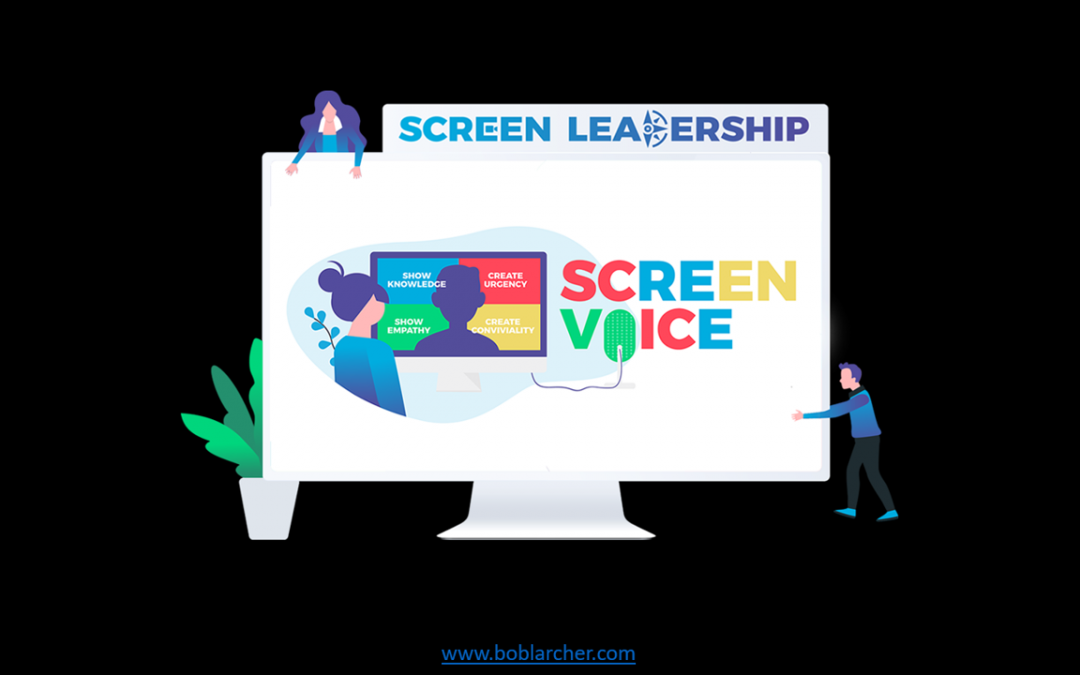Screen leadership is quite simply your ability to incarnate your leadership when working “live” screen-to-screen as opposed to working face-to-face; your ability to influence others intellectually through your arguments, emotionally through your empathy, physically through your actions and spiritually through your values – all the things you can probably do quite well face-to-face, but are more problematic screen-to-screen; which, today, has become the norm, even when people work in the same building, yet cannot meet physically.
When working Screen-to-Screen, what you say, how you say it and the accompanying facial expressions are paramount in creating trust, building relationships, giving feedback and influencing.
In fact, your Screen-Voice is key to both incarnating your Screen-Leadership and developing your Screen-Reputation.
Before I get on to the importance of voice, a few words about facial expressions
Although much body language has disappeared in virtual meetings, our “head & shoulders” still say a lot about us.
When you are in a ZOOM or Teams meeting, people can put your image “full-screen” without you knowing; this means that they can see every frown, every doubt, every scowl, every sideways look at your notes that you make and all of this will contribute to their perception of you and hence your Screen Reputation.
We all rely on facial expressions to help us make judgments concerning the trustworthiness, motives, and emotions of others; be they trying to convince us of something or trying to sell us something.
However, the real game changer when working Screen-to-Screen is your voice; it can make all the difference between success and failure in terms of your impact on the other participants in the meeting; be it a sales meeting, an annual interview or a technical meeting.
To maintain impact, you need to use the 5P’s of your voice: Pitch, Pace, Pause, Projection and Personality
Pitch is about changes in frequency of your voice; the ups and downs of your notes when you speak. We all have a vocal range, from higher notes to lower notes. However, it takes awareness and practice to spot your own frequency (pitch) and to change it consciously.
A monotone voice will undoubtedly bore your audience or the other participants and bored people are less likely to recall your key points or to take action. Too much variation can be distracting and hinder people in following your message.
Pace is simply the speed at which you speak. Just as monotone is boring, so is mono-pace; be it very slow or very fast. There is value in changing your pace as you speak; speeding up the pace of your voice can add excitement whereas, slowing down will help others to focus on what you want to emphasise.
Pausing means stopping momentarily for effect in the middle of your remarks; it is usually used in conjunction with variation of Pace. A pause is best used either before or after a significant point as a way of creating emphasise or allowing people to digest what you have said.
A pause every now and then is also useful for those who tend to speak too fast, by stopping yourself occasionally, you allow the others time to process your key points before you move on to new material.
How you Project your voice is extremely important as it impacts on your audience’s ability to hear your remarks. A well projected voice will allow everyone to hear your comments without having to strain your voice or for them to turn up the volume, or maybe, down, if you over do it.
You can add intrigue when speaking by softening your voice to emphasize a particular point and then increasing the volume for another point; speaking loudly is not about shouting, just as speaking softly is not about whispering. In both cases you need to ensure that everyone can hear each and every point.
Personality is essentially the colour and meaning that comes from hearing your voice. Your voice personality comes from both the words you choose to use and how you say them. To a certain extent it’s a combination of the previous points.
The same phrase said, fast or slow, with or without breaks, high pitched or low pitched and with a slight change of adjectives can convey urgency, conviviality, empathy or authority
The colour of your voice will dictate if people are “turned on” or “turned off” when listening to you.
When getting ready for your screen-to-screen event, be it a meeting, a presentation or a feedback session, consciously prepare how you are going to use your voice.
If you would like to evaluate how well you are using your screen voice; take a look at www.screen-leadership.com and take the Screen-Voice test – you will also find some do’s and don’ts
If you would like help in developing your screen-voice, or other aspects of your screen-leadership, just hit the contact button on the screen-leadership web site.

I help people to develop their interpersonal skills, usually within a leadership or teamwork context. If you are looking to develop your leadership, I might be able to help. I’ve been doing this for almost 40 years; roughly four thousand days of seminars, workshops, conferences, coaching, offsites, webinars, etc. – put back-to-back that makes almost ten “full” years.



